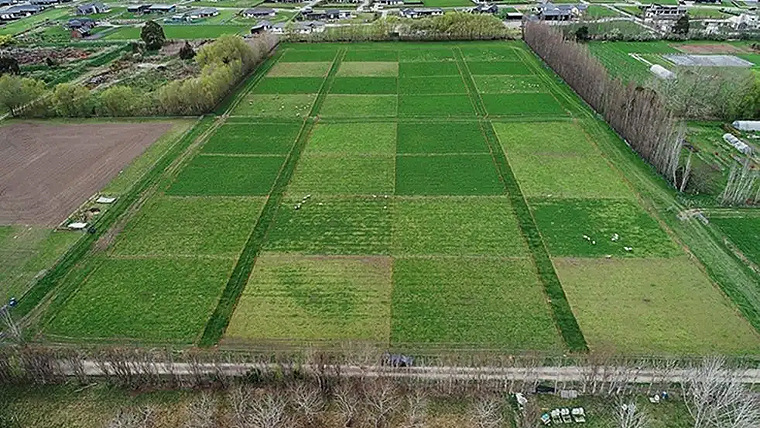
Regenerative agriculture is gaining interest in New Zealand, and at the forefront of this shift is the Whenua Haumanu Programme. A partnership between Massey University and the Ministry for Primary Industries through the Sustainable Food and Fibre Futures fund, it is the most comprehensive programme of its kind in the country.
This week, two Massey University students, Rukshagni Sutharsan and Varthani Susruthan, provided insight into their research and experiences within the programme.
Rukshagni Sutharsan is undertaking her PhD in soil science at Massey University, where she is contributing to a seven-year study under Whenua Haumanu. Her research focuses on biological nitrogen fixation - how nitrogen from the air is converted into a form available to plants. With legumes and free-living microbes playing a critical role in this process, she is investigating how different pasture systems influence nitrogen fixation and, ultimately, soil health.
The study compares two pasture systems: a standard ryegrass-clover mix and a diverse pasture incorporating multiple species. The goal is to understand whether greater pasture diversity leads to improved nitrogen fixation, reducing reliance on synthetic fertilisers. By introducing a variety of legumes, including lucerne and sainfoin, Sutharsan aims to support year-round nitrogen fixation. This, she believes, could reduce fertiliser inputs, lessen environmental impact, and enhance soil health over time.
She is employing advanced techniques to measure nitrogen fixation, including N-15 isotope tracking and enzymatic assays. Future plans involve DNA-based methods to identify active bacteria in different pasture conditions. On a practical level, she is also studying nodule formation on legumes, as farmers can use this as a simple indicator of nitrogen fixation potential in their paddocks.
For Sutharsan, the appeal of this research lies in its focus on sustainability rather than just productivity. “With high production rates, environmental concerns are often overlooked. This programme prioritises soil health and long-term sustainability,” she says. Looking ahead, she hopes to work in agricultural consultancy or directly with farmers to promote sustainable farming practices.
Varthani Susruthan, also a PhD student at Massey, brings a different perspective to the programme. Originally from Sri Lanka, she chose to study in New Zealand due to the country’s strong pasture-based dairy system and its balance between profitability and environmental responsibility. She is particularly interested in how these approaches can be applied in her home country.
Susruthan’s research focuses on pasture ecology and management, examining plant diversity, composition, and pasture growth performance in relation to animal production and welfare. Her work also explores which plant species are most preferred by dairy animals, a crucial factor in optimising pasture systems for both productivity and sustainability.
One key aspect of her study is assessing the effectiveness of tools used to monitor pasture growth, such as the rising plate meter. While widely used in standard ryegrass-clover pastures, its accuracy in more diverse pastures remains uncertain. Preliminary data suggests the tool remains effective, but additional research is underway to validate its accuracy across different systems. She is also investigating alternative measurement methods, including the sward stick, and assessing pasture composition’s impact on milk production, reproduction, and overall farm productivity.
The trial compares three different systems: standard pastures with contemporary management, diverse pastures with regenerative management, and diverse pastures with contemporary management. The aim is to understand how different approaches influence long-term farm performance. Now in its third year, the study continues to yield valuable insights, helping to refine best practices for integrating regenerative principles into existing dairy systems.
Susruthan sees immense value in the Whenua Haumanu program for New Zealand’s primary sector. “This programme is making a significant contribution to understanding both regenerative and contemporary agricultural practices,” she explains. While many regenerative techniques are already used by farmers, the scientific evidence to support and optimise them is still emerging. She believes the findings will help farmers make informed decisions about pasture management, farm sustainability, and environmental stewardship.
Ultimately, the Whenua Haumanu Programme represents a crucial step forward in understanding how regenerative agriculture can work in New Zealand’s unique farming landscape. By combining soil science, pasture management, and dairy production research, it provides a robust foundation for more sustainable farming practices. With researchers like Sutharsan and Susruthan at the helm, the programme is not only advancing academic knowledge but also equipping farmers with the tools and insights needed to navigate the future of agriculture.
Have a listen to the podcast to hear the full story.
Angus Kebbell is the Producer at Tailwind Media. You can contact him here.

We welcome your comments below. If you are not already registered, please register to comment.
Remember we welcome robust, respectful and insightful debate. We don't welcome abusive or defamatory comments and will de-register those repeatedly making such comments. Our current comment policy is here.